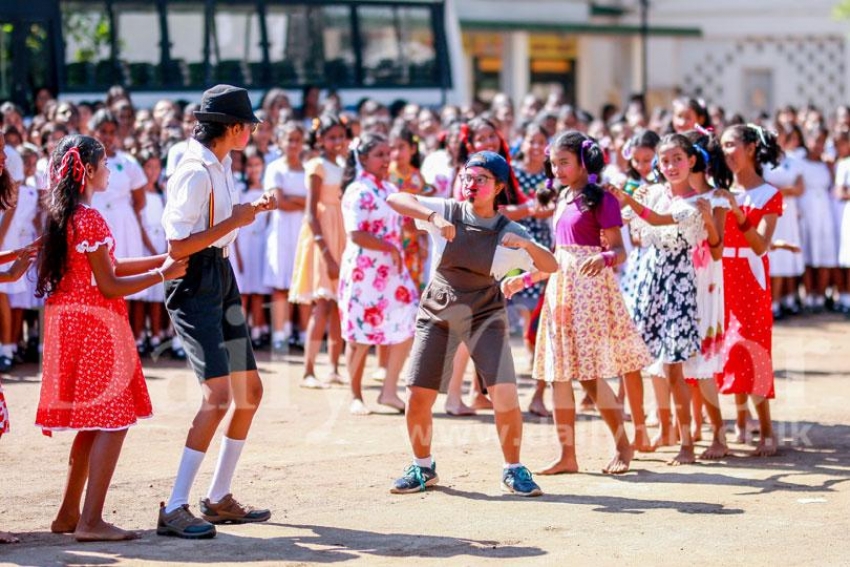Children and elders are two sides of the same coin. After all, one must pass childhood to become an elder. Yesterday (October 1), we celebrated the Universal Elders Dway and the Children’s Day in Sri Lanka, though many countries celebrate the Children’s Day on November 20 after the date which marks the anniversary of the dates when the UN General Assembly adopted both the Declaration and Convention of Children’s Rights.
The Convention, which is the most widely ratified international human rights treaty, sets out a number of children’s rights including the right to life, to health, to education and to play, as well as the right to family life, to be protected from violence, to not be discriminated, and to have their views heard.However, by celebrating these two days together, Sri Lanka offers a unique perspective on the importance of both these segments of the population. Children also get an idea of how important it is to take care of their parents and other elders, a trait that is ingrained in our psyche.
The goal of Universal Children’s day is to improve child welfare worldwide, promote and celebrate children’s rights and promote togetherness and awareness amongst all children. Children in today’s world face a multitude of problems and challenges that the world must come together to resolve.Education is a basic right of every child, but worldwide there are around 300 million children and youth around who do not go to school. They don’t get to put on a uniform and walk or take a bus to school; they don’t get to sit in a classroom, listen to a teacher, read a textbook and take notes. They don’t have the opportunity to learn to read, write and do math. The situation in Sri Lanka is very different, as there is near-universal school attendance by both boys and girls (in many countries, girls are compelled to stay at home doing housework).
It is estimated that there are 1 billion people around the world with disabilities, and at least 1 in 10 are children. Again, the vast majority (90%) of children with disabilities in the developing world do not go to school. They face multiple barriers, from stigma and ignorance, to lack of infrastructure, materials, or trained teachers. Sri Lanka though has very good structures for children with visual and hearing impairments, in particular.
Child labour
Child labour is another problem that has to be tackled. Too many children around the world don’t even have a chance to be children. Worldwide, it is estimated that 150 million children are engaged in child labour. Most often because their families live in poverty, children are asked to contribute to their livelihoods. They do household chores like cleaning, cooking and fetching water, selling goods or working in factories. Child labour can be a couple of hours a day to a full day.
Child soldiers are deployed in many conflicts around the world, which means they have no chance at all for any kind of education, apart from weapons training and the like. It is a harsh life as many of them are abducted in the first place and then compelled to undergo training, with rudimentary facilities and meagre food rations.
Thousands of children are also trafficked for sex and slavery worldwide. Conflicts and terrorist incidents have displaced children and separated them from their parents, as have natural disasters. More than 50 million children have been uprooted from their homes due to conflict, poverty and climate change while millions more face violence in their communities.
The world has to confront the “uncomfortable truth” that around the planet, the rights of millions of children are being violated every day. One can take note of the dire humanitarian situation of children in war-torn Syria and Yemen; the threat posed by extremists in northeastern Nigeria against girls and boys (the Nigerian Police last week rescued hundreds of boys from a virtual slave camp) and the severe nutrition crisis facing millions of children in South Sudan.
“Children’s rights are being violated around the world, in every country, wherever children are the victims of violence, abuse and exploitation, violated wherever they are deprived of an education. Their rights are violated wherever they are denied the chance to make the most of their potential simply because of their race, their religion, their gender, their ethnic group, or because they are living with a disability,” the UNICEF stated recently.
But can the world address these problems? It costs an average US$ 1.25 per child in developing countries (low- and lower-middle income) to provide a full cycle of pre-primary through secondary education (13 years).
The largest share of this cost, 88%, is borne by developing countries themselves. The international community must fill the gap of just 15 cents a day per child to ensure every child can go to school by 2030. This is part of the UN’s Sustainable Development Goals (SDGs). Many functions were held around Sri Lanka to mark the Children’s Day yesterday, with the State ceremony held at the Matale Edward Ground under the patronage of President Maithripala Sirisena.
In his message to mark Children’s Day which is celebrated in Sri Lanka on October 1, President Sirisena emphasized that the young generation is the key to preserve its future prosperity and pride. “The need of the present era is to build a productive young generation, who are equipped with knowledge, skills and high-quality values,” he said. The President added that this year’s Children’s Day would be celebrated in Sri Lanka under the theme ‘Sumithuru Deyakin - Dinawamu Daruwan’.
This call was echoed by Prime Minister Ranil Wickremesinghe, who called on the public to ensure peace and reconciliation in a stable country where the children’s rights and welfare are secured. The Premier said children as the leaders of tomorrow will go on to steer the country’s progress. “It is our responsibility to ensure peace and reconciliation in a stable country where their rights and welfare are secured,” the message said.
Future generations
One cannot also forget the role played by parents and teachers in moulding the future generation. UNICEF has drawn attention to the critical role parents play in a child’s first five years through early care giving, socializing and disciplining practices, which can affect their child’s brain development for their whole lives, and even future generations. Parents play a key role in ensuring children get good nutrition, stimulation and protection, known as ‘eat, play and love’, yet they need more support to ensure their children reach their full potential.
Looking at the other side of the coin – elders - Between 2019 and 2030, the number of persons aged 60 years or over is projected to grow by 46 per cent (from 962 million to 1.4 billion) globally outnumbering youth, as well as children under the age of 10. Moreover, this increase will be the greatest and most rapid in the developing world. Ageing of entire populations is poised to become one of the most significant social transformations of the 21st century.
As the UN notes: Older people have always played a significant role in society as leaders, caretakers and custodians of tradition. Yet they are also highly vulnerable, with many falling into poverty, becoming disabled or facing discrimination. As health care improves, the population of older people is growing. Their needs are also growing, as are their contributions to the world.
The International Day of Older Persons is an opportunity to highlight the important contributions that older people make to society and raise awareness of the opportunities and challenges of ageing in today’s world.
The theme for 2019 is “the Journey to Age Equality”. The 2019 theme aims draw attention to the existence of old age inequalities and how this often results from an accumulation of disadvantages throughout life, and highlight intergenerational risk of increased old age inequalities.
Old age inequalities
The SDGs recognize that development will only be achievable if it is inclusive of all ages. Empowering older persons in all dimensions of development, including promoting their active participation in social, economic and political life, is one way to ensure their inclusiveness and reduce inequalities.
The 2019 theme is aligned with SDG Goal 10 and focuses on pathways of coping with existing — and preventing future — old age inequalities. SDG 10 sets to reduce inequality within — and among — countries, and aims to “ensure equal opportunity and reduce inequalities of outcome,” including through measures to eliminate discrimination, and to “empower and promote the social, economic and political inclusion of all, irrespective of age, sex, disability, race, ethnicity, origin, religion or economic or other status.”
Often, disparities in old age reflect an accumulated disadvantage characterized by factors such as: location, gender, socio-economic status, health and income. In this regard, trends of ageing and economic inequality interact across generations and rapid population ageing, demographic and societal or structural changes alone, can exacerbate older age inequalities, thereby limiting economic growth and social cohesion.
In 2014, Governments around the world adopted a resolution at the Economic and Social Council that recognized ageism as “the common source of, the justification for and the driving force behind age discrimination.” Such discrimination shapes how older persons are treated and perceived by their societies, including in medical settings and workplaces, creating environments that limit older persons’ potential and impact their health and well-being. The failure to tackle ageism undermines older persons’ rights and hinders their contributions to social, economic, cultural and political life.
In fact, the booming silver generation is posing serious questions for many countries. Between 1950 and 2010 life expectancy worldwide rose from 46 to 68 years, and it is projected to increase to 81 by the end of the century in most developed and developing countries such as Sri Lanka which have good health indices.
The biggest challenge faced by Governments is managing an ageing population. The best answer is keeping them productive. Some countries have raised the mandatory retirement to above 60, but the bigger challenge is finding avenues to keep them occupied even after a late retirement. There are many jobs which do not require much physical exertion that can be done by older persons.
The rapid advances in medicine over the past few decades have enabled millions more to live to a ripe old age, but this puts Governments and health care authorities in a dilemma – healthcare costs have spiraled as more people live longer but require advanced medication, surgery and other procedures.
There is no single solution to the problem of managing an aging population. The best approach is to think of them as an asset and evolve programmes that enable them to give their best to the society in the twilight of their life.




















